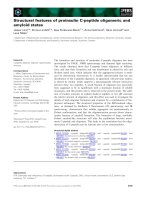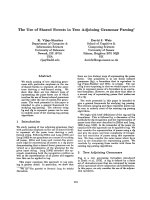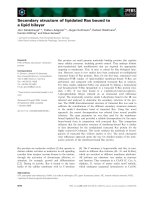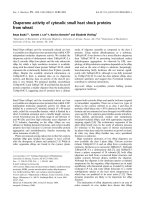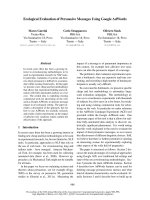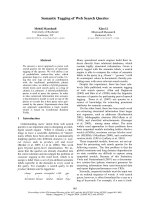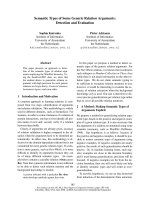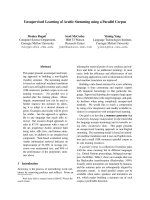Báo cáo khoa học: "Semantic enrichment of journal articles using chemical named entity recognition" pptx
Bạn đang xem bản rút gọn của tài liệu. Xem và tải ngay bản đầy đủ của tài liệu tại đây (78.46 KB, 4 trang )
Proceedings of the ACL 2007 Demo and Poster Sessions, pages 45–48,
Prague, June 2007.
c
2007 Association for Computational Linguistics
Semantic enrichment of journal articles using chemical named entity
recognition
Colin R. Batchelor
Royal Society of Chemistry
Thomas Graham House
Milton Road
Cambridge
UK CB4 0WF
Peter T. Corbett
Unilever Centre for Molecular Science Informatics
University Chemical Laboratory
Lensfield Road
Cambridge
UK CB2 1EW
Abstract
We describe the semantic enrichment of journal
articles with chemical structures and biomedi-
cal ontology terms using Oscar, a program for
chemical named entity recognition (NER). We
describe how Oscar works and how it can been
adapted for general NER. We discuss its imple-
mentation in a real publishing workflow and pos-
sible applications for enriched articles.
1 Introduction
The volume of chemical literature published has ex-
ploded over the past few years. The crossover between
chemistry and molecular biology, disciplines which of-
ten study similar systems with contrasting techniques and
describe their results in different languages, has also in-
creased. Readers need to be able to navigate the literature
more effectively,and also to understand unfamiliar termi-
nology and its context. One relatively unexplored method
for this is semantic enrichment. Substructure and simi-
larity searching for chemical compounds is a particularly
exciting prospect.
Enrichment of the bibliographic data in an article with
hyperlinked citations is now commonplace. However,
the actual scientific content has remained largely unen-
hanced, this falling to secondary services and experimen-
tal websites such as GoPubMed (Delfs et al., 2005) or
EBIMed (Rebholz-Schuhmann et al., 2007). There are
a few examples of semantic enrichment on small (a few
dozen articles per year) journals such as Nature Chemi-
cal Biology being an example, but for a larger journal it
is impractical to do this entirely by hand.
This paper concentrates on implementing semantic
enrichment of journal articles as part of a publishing
workflow, specifically chemical structures and biomedi-
cal terms. In the Motivation section, we introduce Oscar
as a system for chemical NER and recognition of ontol-
ogy terms. In the Implementation section we will discuss
how Oscar works and how to set up ontologies for use
with Oscar, specifically GO. In the Case study section we
describe how the output of Oscar can be fed into a pub-
lishing workflow. Finally we discuss some outstanding
ambiguity problems in chemical NER. We also compare
the system to EBIMed (Rebholz-Schuhmann et al., 2007)
throughout.
2 Motivation
There are three routes for getting hold of chemical
structures from chemical text—from chemical compound
names, from author-supplied files containing connection
tables, and from images. The preferred representation
of chemical structures is as diagrams, often annotated
with curly arrows to illustrate the mechanisms of chem-
ical reactions. The structures in these diagrams are typ-
ically given numbers, which then appear in the text in
bold face. However, because text-processing is more ad-
vanced in this regard than image-processing, we shall
concentrate on NER, which is performed with a sys-
tem called Oscar. A preliminary overview of the sys-
tem was presented by Corbett and Murray-Rust (2006).
Oscar is open source and can be downloaded from
/>As a first step in representing biomedical content, we
identify Gene Ontology (GO) terms in full text.
1
(The
Gene Ontology Consortium, 2000) We have chosen a rel-
atively simple starting point in order to gain experience
in implementing useful semantic markup in a publishing
workflow without a substantial word-sense disambigua-
tion effort. GO terms are largely compositional (Mungall,
2004), hence incomplete matches will still be useful, and
that there is generally a low level of semantic ambiguity.
For example, there are only 133 single-word GO terms,
which significantly reduces the chance of polysemy for
the 20000 or so others. In contrast, gene and protein
1
We also use other OBO ontologies, specifically those for
nucleic acid sequences (SO) and cell type (CL).
45
(.
*
) activity$ → (\1)
(.
*
) formation$ → ∅
(.
*
) synthesis$ → ∅
ribonuclease → RNAse
→ ribonuclease
ˆalpha- (etc.) → α- (etc.)
→ alpha- (etc.)
pluralize nouns
stopwords → ∅
Table 1: Example rules from ‘Lucinda’, used for generat-
ing recogniser input from OBO files
names are generally short, non-compositional and often
polysemous with ordinary English words such as Cat or
Rat.
3 Implementation
Oscar is intended to be a component in larger workflows,
such as the Sciborg system (Copestake et al., 2006). It
is a shallow named-entity recogniser and does not per-
form deeper parsing. Hence there is no analysis of the
text above the level of the term, with the exception of
acronym matching, which is dealt with below, and some
treatment of the boldface chemical compound numbers
where they appear in section headings. It is optimized
for chemical NER, but can be extended to handle general
term recognition. The EBIMed system, in contrast, is a
pipeline, and lemmatizes words as part of a larger work-
flow.
To identify plurals and other variants of non-chemical
NEs we have a ruleset, nicknamed Lucinda, outlined in
Table 1, for generating the input for the recogniser from
external data. We use the plain-text OBO 1.2 format,
which is the definitive format for the dissemination of the
OBO ontologies.
We strive to keep this ruleset as small as possible, with
the exception of determining plurals and a few other reg-
ular variants. The reason for keeping plurals outside the
ontology is that plurals in ordinary text and in ontologies
can have quite different meanings.
There is also a short stopword list applied at this stage,
which is different from Oscar’s internal stopword han-
dling, described below.
3.1 Named entity recognition and resolution
Oscar has a recogniser to identify chemical names and
ontology terms, and a resolver which matches NEs to on-
tology IDs or chemical structures. The recogniser classi-
fies NEs according to the scheme in Corbett et al. (2007).
The classes which are relevant here are CM, which iden-
tifies a chemical compound, either because it appears in
Oscar’s chemical dictionary, which also contains struc-
2
5 8 5
\s
4
5 8 0
\s
X
1
6
2
6
2 2
\s
X
1
6
3
X 1 6 4
Figure 1: Cartoon of part of the recogniser. The mapping
between this automaton and example GO terms is given
in Table 2.
GO term Regex pair
bud neck 2585\s4580\s
2585\s4580\sX162
bud neck polarisome 2585\s4580\s622\s
2585\s4580\s622\sX163
polarisome 622\s
622\sX164
Table 2: Mapping in Fig. 1. The regexes are purely il-
lustrative. IDs 162, 163 and 164 map on to GO:0005935,
GO:0031560 and GO:0000133 respectively.
tures and InChIs,
2
or according to Oscar’s n-gram model,
regular expressions and other heuristics and ASE, a sin-
gle word ending in “-ase” or “-ases” and representing an
enzyme type. We add the class ONT to these, to cover
terms found in ontologies that do not belong in the other
classes, and STOP, which is the class of stopwords.
We sketch the recogniser in Fig. 1. To build the recog-
niser: Each term in the input data is tokenized and the
tokens converted into a sequence of digits followed by a
space. These new tokens are concatenated and converted
into a pair of regular expressions. One of these expres-
sions has X followed by a term ID appended to it. These
regex–regex pairs are converted into finite automata, the
union of which is determinized. The resulting DFA is ex-
amined for accept states. For each accept state for which
a transition to X is also present, the sequences of digits
after the X is used to build a mapping of accept states to
ontology IDs (Table 2).
To apply the recogniser: The input text is tokenized,
and for each token a set of representations is calculated
which map to sequences of digits as above. We then make
an empty set of DFA instances (a pointer to the DFA,
2
An InChI is a canonical identifier for a chemical com-
pound. />46
which state it’s in and which tokens it has matched so
far), and for each token, add a new DFA instance for each
DFA, and for each representation of the token, clone the
DFA instance. If it does not accept the digit-sequence
representation of the token, throw it away. If it is in an
accept state, note which tokens it has matched, and if the
accept state maps to an ontology ID (ontID), we have an
NE which can be annotated with the ontID.
Take all of the potential NEs. For all NEs that have the
same sequence of tokens, share all of the ontIDs. Assign
its class according to a priority list where STOP comes
first and CM precedes ASE and ONT. For the system in
Fig. 1, the phrase “bud neck polarisome” matches three
IDs. We choose the longest–leftmost sequence. If the
resolver generates an InChI for an NE, we look up this
InChI in ChEBI (de Matos et al., 2006), a biochemical
ontology, and take the ontology ID. This has the effect
of aligning ChEBI with other databases and systematic
nomenclature.
3.2 Gene Ontology
In working out how to mine the literature for GO terms,
we have taken our lead from the domain experts, the GO
editors and the curators of the Gene Ontology Annotation
(GOA) database.
The Functional Curation task in the first BioCreative
exercise (Blaschke et al., 2005) is the closest we have
found to a systematic evaluation of GO term identifica-
tion. The brief was to assign GO annotations to human
proteins and recover supporting text. The GOA curators
evaluated the results (Camon et al., 2005) and list some
common mistakes in the methods used to identify GO
terms. These include annotating to obsolete terms, pre-
dicting GO terms on too tenuous a link with the original
text, for example in one case the phrase “pH value” was
annotated to “pH domain binding” (GO:0042731), diffi-
culties with word order, and choosing too much support-
ing text, for example an entire first paragraph of text.
So at the suggestion of the GO editors, Oscar works on
exact matches to term names (as preprocessed above) and
their exact (within the OBO syntax) synonyms.
The most relevant GO terms to chemistry concern en-
zymes, which are proteins that catalyse chemical pro-
cesses. Typically their names are multiword expressions
ending in “-ase”. The enzyme A B Xase will often be
represented by GO terms “A B Xase activity”, a descrip-
tion of what the enzyme does, and “A B Xase complex”,
a cellular component which consists of two or more pro-
tein subunits. In general the bare phrase “A B Xase” will
refer to the activity, so the ruleset in Table 1 deletes the
word “activity” from the GO term.
We shall briefly compare our method with the algo-
rithms in EBIMed and GoPubMed. The EBIMed algo-
rithm for GO term identification is very similar to ours,
except for the point about lemmatization listed above, and
its explicit variation of character case, which is handled
in Oscar by its case normalization algorithm. In contrast,
the algorithm in GoPubMed works by matching short
‘seed’ terms and then expanding them. This copes with
cases such as “protein threonine/tyrosine kinase activity”
(GO:0030296) where the full term is unlikely to be found
in ordinary text; the words “protein” and “activity” are
generally omitted. However, the approach in (Delfs et
al., 2005) cannot be applied blindly; the authors claim for
example that “biosynthesis” can be ignored without com-
promising the reader’s understanding. In chemistry jour-
nal articles most mentions of a chemical compound will
not refer to how it is formed in nature; they will refer to
the compound itself, its analogues or other processes. In
fact, our ruleset in Table 1 explicitly disallows GO term
synonyms ending in “ synthesis” or “ formation” since
they do not necessarily represent biological processes. It
is also not clear from Delfs et al. (2005) how robust the
algorithm is to the sort of errors identified by Camon et
al. (2005).
4 Case study
The problem is to take a journal article, apply meaningful
and useful annotations, connect them to stable resources,
allow technical editors to check and add further annota-
tions, and disseminate the article in enriched form.
Most chemical publishers use XML as a stable format
for maintaining their documents for at least some stages
of the publication process. The Sciborg project (Copes-
take et al., 2006) and the Royal Society of Chemistry
(RSC) use SciXML (Rupp et al., 2006) and RSC XML
respectively. For the overall Sciborg workflow, standoff
annotation is used to store the different sets of annota-
tions. For the purposes of this paper, however, we make
use of the inline output of Oscar, which is SciXML with
<ne> elements for the annotations.
Not all of the RSC XML need be mined for NEs;
much of it is bibliographic markup which can confuse
parsers. Only the useful parts are converted into SciXML
and passed to Oscar, where they are annotated. These
SciXML annotations are then pasted back into the RSC
XML, where they can be checked by technical editors.
In running text, NEs are annotated with an ID local
to the XML file, which refers to <compound> and
<annotation> elements in a block at the end, which
contain chemical structure information and ontology IDs.
This is a lightweight compromise between pure standoff
and pure inline annotation.
We find useful annotations by aggressive threshold-
ing. The only classes which survive are ONTs, and those
CMs which have a chemical structure found by the re-
solver. This enables the chemical NER part of Oscar
to be tuned for high recall even as part of a publishing
47
workflow. Only CMs which correspond to an unambigu-
ous molecule or molecular ion are treated as a chemical
compound; everything else is referred to an appropriate
ontology. We use the InChI as a stable representation for
chemical structure, and the curated OBO ontologies for
biomedical terms.
The role of technical editors is to remove faulty anno-
tations, add new compounds to the chemical dictionary,
based on chemical structures supplied by authors, sug-
gest new GO terms to the ontology curators, and extend
the stopword lists of both Oscar and Lucinda as appropri-
ate. At present (May 2007), this happens after publication
of articles on the web, but is intended to become part of
the routine editing process in the course of 2007.
This enriched XML can then be converted into HTML
and RSS by means of XSL stylesheets and database
lookups, as in the RSC’s Project Prospect.
3
The imme-
diate benefits of this work are increased readability of ar-
ticles for readers and extensive cross-linking with other
articles that have been enhanced in the same way. Fu-
ture developments could easily involve structure-based
searching, ontology-based search of journal articles, and
finding correlations between biological processes and
small molecule structures.
5 Ambiguity in chemical NER
One important omission is disambiguating the exact ref-
erent of a chemical name, which is not always clear with-
out context. For example “the pyridine 6”, is a class de-
scription, but the phrase “the pyridine molecule” refers to
a particular compound. ChEBI, which contains an ontol-
ogy of molecular structure, uses plurals to indicate chem-
ical classes, for example “benzenes”, which is often, but
not always, what “benzenes” means in text. Currently
Oscar does not distinguish between singular and plural.
Amino acids and saccharides are particularly trouble-
some on account of homochirality. Unless otherwise
specified, “histidine” and “ribose” specify the molecules
with the chirality found in nature, or to be precise,
L-histidine and D-ribose respectively. What is even
worse is that “histidine” seldom refers to the independent
molecule; it usually means the histidine residue, part of a
larger entity.
6 Acknowledgements
We thank Dietrich Rebholz-Schuhmann for useful dis-
cussions. CRB thanks Jane Lomax, Jen Clark, Amelia
Ireland and Midori Harris for extensive cooperation and
help, and Richard Kidd, Neil Hunter and Jeff White at
the RSC. PTC thanks Ann Copestake and Peter Murray-
Rust for supervision. This work was funded by EPSRC
(EP/C010035/1).
3
/>References
Christian Blaschke, Eduardo Andres Leon, Martin
Krallinger and Alfonso Valencia. 2005. Evaluation
of BioCreAtIvE assessment of task 2 BMC Bioinfor-
matics 6(Suppl 1):S16
Evelyn B. Camon, Daniel G. Barrell, Emily C. Dimmer,
Vivian Lee, Michele Magrane, John Maslen, David
Binns and Rolf Apweiler. 2005. An evaluation of GO
annotation retrieval for BioCreAtIvE and GOA BMC
Bioinformatics 6(Suppl 1):S17
Ann Copestake, Peter Corbett, Peter Murray-Rust, C. J.
Rupp, Advaith Siddharthan, Simone Teufel and Ben
Waldron. 2006. An Architecture for Language Tech-
nology for Processing Scientific Texts. In Proceedings
of the 4th UK E-Science All Hands Meeting. Notting-
ham, UK.
Peter Corbett, Colin Batchelor and Simone Teufel. 2007.
Annotation of Chemical Named Entities. In Proceed-
ings of BioNLP in ACL (BioNLP’07).
Peter T. Corbett and Peter Murray-Rust. 2006. High-
throughput identification of chemistry in life science
texts. LNCS, 4216:107–118.
P. de Matos, M. Ennis, M. Darsow, M. Guedj, K. Degt-
yarenko, and R. Apweiler. 2006. ChEBI - Chemical
Entities of Biological Interest Nucleic Acids Research,
Database Summary Paper 646.
The Gene Ontology Consortium. 2000. Gene Ontology:
Tool for the Unification of Biology Nature Genetics,
25:25–29.
Ralph Delfs, Andreas Doms, Alexander Kozlenkov and
Michael Schroeder. 2004. GoPubMed: Exploring
PubMed with the GeneOntology. Proceedings of Ger-
man Bioinformatics Conference, 169–178.
Christopher J. Mungall. 2004. Obol: integrating lan-
guage and meaning in bio-ontologies. Comparative
and Functional Genomics, 5:509–520.
Dietrich Rebholz-Schuhmann, Harald Kirsch, Miguel
Arregui, Sylvain Gaudan, Mark Riethoven and Peter
Stoehr. 2007. EBIMed—text crunching to gather
facts for proteins from Medline. Bioinformatics,
23(2):e237–e244.
C. J. Rupp, Ann Copestake, Simone Teufel and Benjamin
Waldron. 2006. Flexible Interfaces in the Application
of Language Technology to an eScience Corpus. In
Proceedings of the 4th UK E-Science All Hands Meet-
ing. Nottingham, UK.
48
